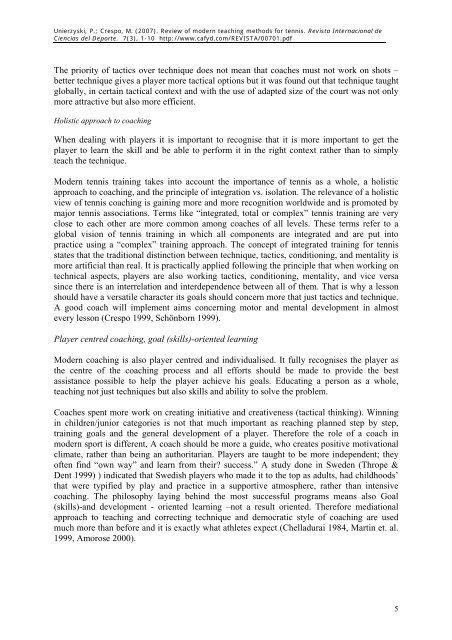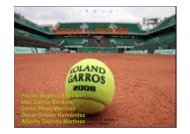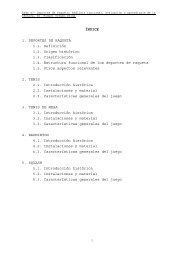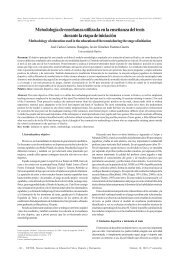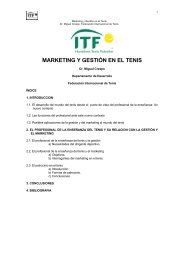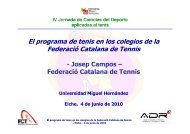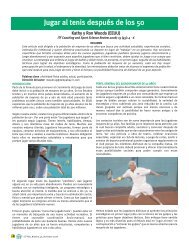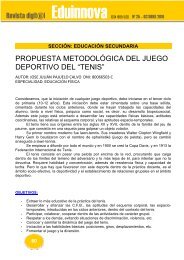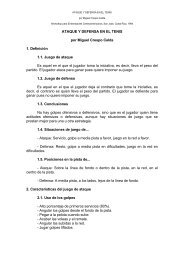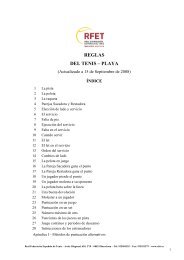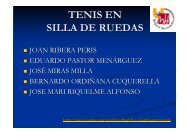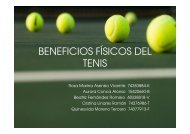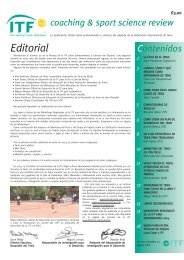Review of modern teaching methods for tennis ... - Miguel Crespo
Review of modern teaching methods for tennis ... - Miguel Crespo
Review of modern teaching methods for tennis ... - Miguel Crespo
You also want an ePaper? Increase the reach of your titles
YUMPU automatically turns print PDFs into web optimized ePapers that Google loves.
Unierzyski, P.; <strong>Crespo</strong>, M. (2007). <strong>Review</strong> <strong>of</strong> <strong>modern</strong> <strong>teaching</strong> <strong>methods</strong> <strong>for</strong> <strong>tennis</strong>. Revista Internacional deCiencias del Deporte. 7(3), 1-10 http://www.cafyd.com/REVISTA/00701.pdfThe priority <strong>of</strong> tactics over technique does not mean that coaches must not work on shots –better technique gives a player more tactical options but it was found out that technique taughtglobally, in certain tactical context and with the use <strong>of</strong> adapted size <strong>of</strong> the court was not onlymore attractive but also more efficient.Holistic approach to coachingWhen dealing with players it is important to recognise that it is more important to get theplayer to learn the skill and be able to per<strong>for</strong>m it in the right context rather than to simplyteach the technique.Modern <strong>tennis</strong> training takes into account the importance <strong>of</strong> <strong>tennis</strong> as a whole, a holisticapproach to coaching, and the principle <strong>of</strong> integration vs. isolation. The relevance <strong>of</strong> a holisticview <strong>of</strong> <strong>tennis</strong> coaching is gaining more and more recognition worldwide and is promoted bymajor <strong>tennis</strong> associations. Terms like “integrated, total or complex” <strong>tennis</strong> training are veryclose to each other are more common among coaches <strong>of</strong> all levels. These terms refer to aglobal vision <strong>of</strong> <strong>tennis</strong> training in which all components are integrated and are put intopractice using a “complex” training approach. The concept <strong>of</strong> integrated training <strong>for</strong> <strong>tennis</strong>states that the traditional distinction between technique, tactics, conditioning, and mentality ismore artificial than real. It is practically applied following the principle that when working ontechnical aspects, players are also working tactics, conditioning, mentality, and vice versasince there is an interrelation and interdependence between all <strong>of</strong> them. That is why a lessonshould have a versatile character its goals should concern more that just tactics and technique.A good coach will implement aims concerning motor and mental development in almostevery lesson (<strong>Crespo</strong> 1999, Schönborn 1999).Player centred coaching, goal (skills)-oriented learningModern coaching is also player centred and individualised. It fully recognises the player asthe centre <strong>of</strong> the coaching process and all ef<strong>for</strong>ts should be made to provide the bestassistance possible to help the player achieve his goals. Educating a person as a whole,<strong>teaching</strong> not just techniques but also skills and ability to solve the problem.Coaches spent more work on creating initiative and creativeness (tactical thinking). Winningin children/junior categories is not that much important as reaching planned step by step,training goals and the general development <strong>of</strong> a player. There<strong>for</strong>e the role <strong>of</strong> a coach in<strong>modern</strong> sport is different, A coach should be more a guide, who creates positive motivationalclimate, rather than being an authoritarian. Players are taught to be more independent; they<strong>of</strong>ten find “own way” and learn from their? success.” A study done in Sweden (Thrope &Dent 1999) ) indicated that Swedish players who made it to the top as adults, had childhoods’that were typified by play and practice in a supportive atmosphere, rather than intensivecoaching. The philosophy laying behind the most successful programs means also Goal(skills)-and development - oriented learning –not a result oriented. There<strong>for</strong>e mediationalapproach to <strong>teaching</strong> and correcting technique and democratic style <strong>of</strong> coaching are usedmuch more than be<strong>for</strong>e and it is exactly what athletes expect (Chelladurai 1984, Martin et. al.1999, Amorose 2000).5


